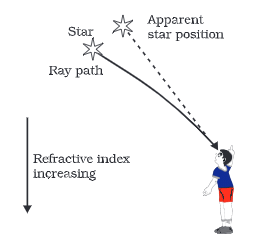Atmospheric Refraction & Scattering of Light | Science Class 10 PDF Download
Atmospheric Refraction
The bending of light as it travels through different layers of the atmosphere is known as atmospheric refraction.
- The twinkling of a star occurs because of atmospheric refraction of starlight.
- Stars near the horizon look a bit higher than where they actually are due to atmospheric refraction.
- We can see the Sun about two minutes before it actually rises and about two minutes after it sets because of atmospheric refraction.
- The Sun's round shape seems flattened at sunrise and sunset, which is also due to this phenomenon.
1. An object placed behind the fire or a hot surface appears to flicker when seen through the air.
- The air above the hot surface becomes hot and rises. The space is occupied by cool air. The refractive index of hot air is less than that of cool air.
- So, the physical condition of the medium is not constant.
- Due to the changing Refractive Index (RI) of the medium, the light appears to come from different directions.
- It results in fluctuation in the apparent position of the object.
2. Stars, when seen near the horizon, appear slightly higher than their actual position due to atmospheric refraction.
- The refractive index of the earth’s atmosphere, in general, increases from top to bottom.
- So, the light coming from a star near the horizon has to travel from rarer to denser medium and it bends towards the normal.
- As a result, the star appears higher.
3. Advanced sunrise

- Stars seen close to the horizon appear a bit higher than their true position due to atmospheric refraction.
- The refractive index of the atmosphere generally increases from the top to the bottom. As light from a star travels from a less dense to a denser medium, it bends towards the normal, making the star seem higher.
- The position of the star is not fixed and can change slightly due to varying conditions in the atmosphere.
4. Twinkling of stars
- Stars are very far from us, so they behave as a point source of light.
- Since the physical conditions of the Earth’s atmosphere are not constant, the light from
- Stars appear to come from different directions.
- This results in fluctuation of the apparent position of the star.
- The amount of light coming from stars also varies due to the changing Refractive Index of the atmosphere.
- The star appears bright when more light from the star reaches our eyes, and the same star appears dull when less amount of light reaches our eyes.
- Both these effects are responsible for the twinkling of stars.
Scattering effect
Spreading of light in various directions by colloid particles.
Scattering ∝ 1/wavelength
Tyndall effect: When light passes through a colloid its path becomes visible. This is called Tyndall effect.
Example:
(i) Path of light becomes visible when light enters a dark and dusty room through a slit or ventilator.
(ii) Path of light becomes visible when light passes through dense canopy of trees in a forest.
Dependence of colour of scattered light
(i) If particles are very fine, they scatter mainly the blue colour of light (shorter wavelength).
(ii) Medium sized particles scatter mainly the red colour (longer wavelength).
(iii) Even larger particles scatter all the colours of light that is why it appears white.
Wavelength of red light is about 1.8 times to that of blue light.
Anger signs are made in red colour.
- Red is the least scattered colour, which is why it is visible over long distances in fog and smoke.
- This is also the reason danger signs are made in red.
Colour of sky appears blue on a clear day.
- The upper layer of the atmosphere contains very fine particles of water vapour and gases.
- The molecules of air and other small particles are smaller than the wavelength of visible light.
- Fine particles mainly scatter blue light, while larger particles scatter light of longer wavelengths.
- If the scattering particles are large enough, the scattered light can appear white. This is why the sky looks blue.
Appearance of sky to an astronaut in the space
- The sky would appear dark to an astronaut in the space as scattering is not very prominent at such high altitude due to absence of particles.
Clouds appear white
- Clouds are formed from water vapour that condenses into droplets.
- Due to the larger size of these droplets, scattered light can appear white.
- All colours of light are scattered, making clouds look white.
Colour of sun appear red during sunrise and sunset (Old Syllabus)
- At sunset and sunrise, the sun and its surroundings appear red.
- During these times, the sun is near the horizon, and sunlight travels a longer distance through the atmosphere.
- This longer path scatters most of the blue light (shorter wavelengths).
- Red light has a longer wavelength, which allows it to reach our eyes.
- The apparent flattening of the sun's disc at these times is due to the same scattering effect.
|
80 videos|569 docs|80 tests
|
FAQs on Atmospheric Refraction & Scattering of Light - Science Class 10
| 1. What is atmospheric refraction and how does it affect our perception of objects in the sky? |  |
| 2. How does atmospheric scattering differ from atmospheric refraction? |  |
| 3. What are some real-life examples of atmospheric refraction that we can observe? |  |
| 4. Why do we see a red sky during sunrise and sunset in relation to scattering? |  |
| 5. How does atmospheric refraction impact navigation and astronomy? |  |





















